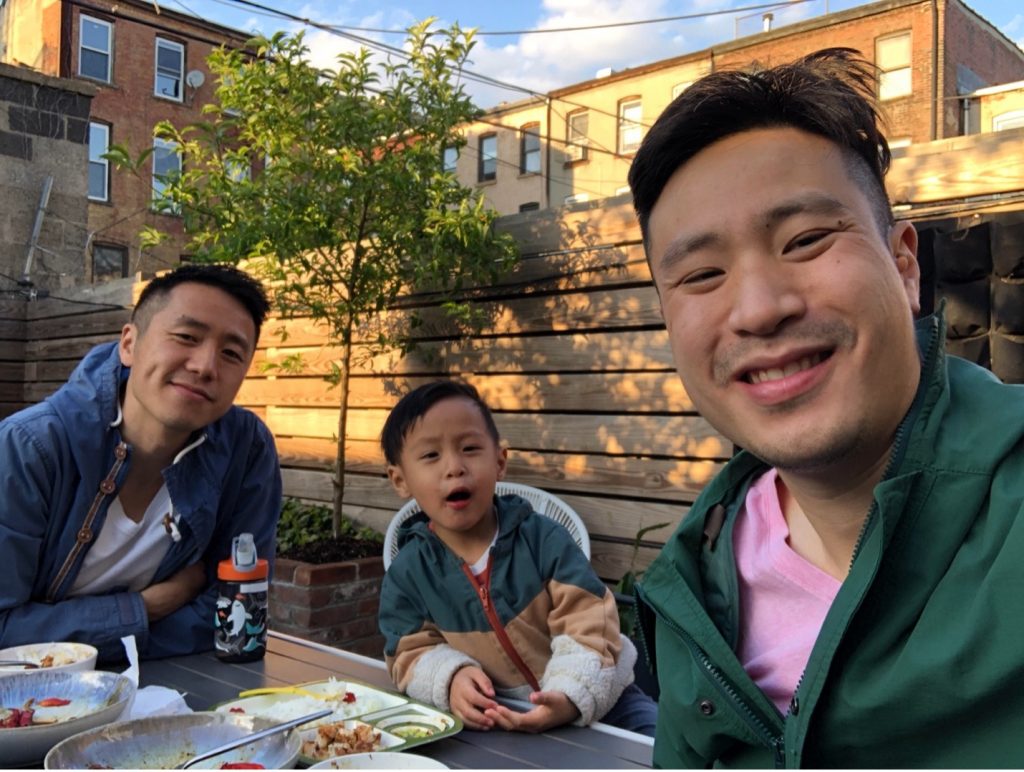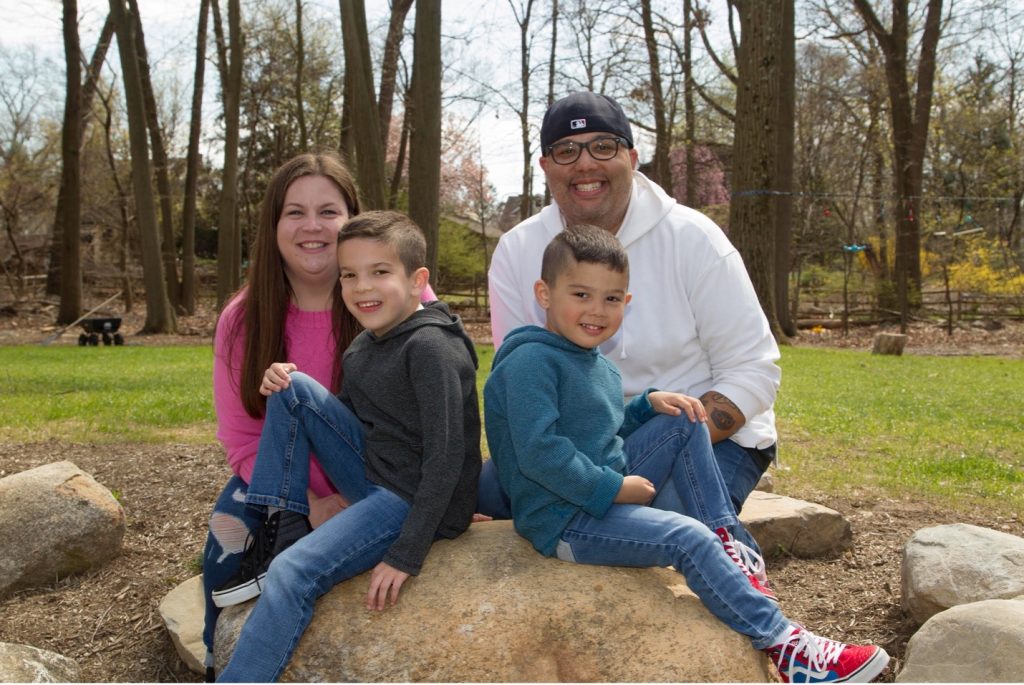A year and a half into the pandemic, the shift in how fathers view their responsibilities at home is worth noting. Much of the gender inequality in the workforce has been driven by forces in the domestic landscape — far more moms than dads scale back or step away from their careers to care for young children, sick parents or spouses, and manage the household.
Eroding or nixing this imbalance is key to greater equality in the workplace — and one of the first steps to manifesting this? Awareness. Many of the dads interviewed shared how their eyes had been opened to all the invisible work their partners did to keep things going. And now that they see a fuller picture of what balancing work and home life looks like, they are better positioned to share more fully in the totality of that experience. Here’s to silver linings and the dividends that may echo and grow as we segue into the new normal.
 Steve H.
Steve H.
Father to Jacob, Age 3
Married to Henry
Lives in Bed-Stuy, Brooklyn, in New York City
+ What has been your experience as a working dad during the pandemic?
In our household, there are two dads figuring it out. My partner, Henry, and I have Jacob, who is three years old. He was born through surrogacy . Our collective experience in terms of working during the pandemic, in a word: stressful.
It’s hard balancing work, childcare, and family time. It took us a while to figure it out, and now we carefully plan each day together and align on the next day’s game plan every night — but it can sometimes be hard to plan because we are independent consultants, and things pop up. We try our best to even it out, but it will never be perfectly 50/50. We often end up making up work that didn’t get done during the day during the evening after Jacob goes to bed. It’s non-stop. A toddler is a handful
+ What kind of work do you do? Where do you work?
We have both been self-employed for the last four years — Henry is in real estate, while I am more of a design consultant and project manager. Sometimes our professional worlds overlap, sometimes they don’t.
+ What is Jacob’s school situation?
Our son is enrolled at The Co-op School four days a week. Initially, Jacob was only registered for two days in 2020 since we were unsure how the Covid situation would play out in the school environment. As we grew more comfortable, we slowly increased our son’s days to three days per week — and then to four. We kept Fridays open for family time. A BIG shout out to The Co-op School for making in-person education work for 2020-2021. They’ve been amazing keeping the school safe, open, and enjoyable for everyone! We are incredibly grateful for the experience we have had.
+ How have you gotten work done with Jacob home?
Last spring, when there was no childcare — and even now — we take shifts. Morning, afternoon, then dinner and bath time together. Everyone gets some time. We rotate bedtime routine and cooking. It’s fair and balanced, but it’s also hard for both of us to spend time together as an entire family. And once our son is asleep — it’s back to work. There’s no real downtime, and that’s been a bit challenging. I’m surprised and proud that we’ve been at this for more than a year, and we’re still doing alright!
Jacob is super-hyper, and it takes a village, but the village during Covid was my husband and me. Now we hire one of the support teachers at Co-op School to help us fill in the gaps.
+ Have you gotten any help from a partner?
Yes — and from extended family and nannies. My partner and I take turns for child duty, whether that’s taking Jacob to school, picking him up, or taking him out to the playground. I feel fortunate that we have the flexibility and can work around our schedules, but the tradeoff is that we often work late into the night.
+ What has been the most difficult thing about fathering and working and existing this past year?
Finding a balance between personal time and family time; I think we all need a breather, and finding that quiet moment can be challenging while working and taking care of life during a pandemic. It’s essential to find a few minutes for yourself every day just to de-stress and do something mind-numbing or mind distracting. For me, that’s enjoying a TV episode of anything that resembles “normalcy.” I think we all miss that.
Erosion between work and life, with everything just blending together, has been difficult to surmount. When you’re self-employed, the to-do list is tough to tackle.
+ Has there been a best part?
During the lockdown, spending time at home together in the backyard or taking long walks brought a lot of joy. For a few months, our work completely came to a standstill. It was nice having no work and all family time — but I think after a few weeks of that, we were all getting itchy too…
+ What would help working fathers in this country?
Quality and affordable childcare. It’s especially challenging in New York City, where everything is already expensive, from housing to healthcare. Having a good education is deeply important for me, so I’m really grateful for The Co-op School being open and flexible during the time of the pandemic.
When we had Jacob, I wasn’t working, I took a year off, and at that time, my partner did have a corporate job and had two months of paid parental leave. And he took all two months. You hear about unlimited vacation and leave, but I think it can be something of a show. The more potential PTO is on the table, the fewer people may actually take it. I used to be in corporate, and my company introduced six months of paternal leave, but my boss said de facto, “You’re not going to take six months, are you?” By the time I had Jacob, I wasn’t there.
+ How important is community for you in terms of being a same-sex parent?
Community is key. We found community by going to our local park and library in Bed-Stuy. The Macon Library storytime was a great place to meet local parents who would congregate there. And going to the playground, I’ve met other same-sex couple parents — the community is more extensive than I thought. It’s a great vibe; all the parents and caregivers know each other and look out for one another.
 Brian Young
Brian Young
Father to two boys — Hudson, 7 and Mason, 4
Married to Nicole
Lives in Midland Park, New Jersey
+ What has been your experience as a working dad during the pandemic?
It’s been interesting. Both my wife and I have been working from home since last March. She’s a teacher. Our boys are doing virtual learning, but one of them is in preschool. We haven’t had any help in the home. As you might imagine, our hands are full — two kids, three dogs, two full-time jobs — all of us working and learning together.
Our youngest son, Mason, went back to preschool part-time in the fall of 2020, but we kept our older son, Hudson, home. My wife has been teaching the entire past year virtually. The juggling act has been supreme.
+ What kind of work do you do? Where do you work?
I work at Creative Circle, leading a team of recruiters and placing candidates in opportunities. I am focused on the tri-state area. I live in Bergen County, NJ, and my office is (historically) in NYC.
+ What is your children’s school situation?
Hudson is completing a virtual year of 2nd grade. Mason has been in a truncated schedule of in-person pre-school. It was nice having him home, but it was also nice having him back in school (laughing).
+ How have you gotten work done with the kids home?
We converted an extra bedroom into an office. Nicole would teach her classes in that room, Hudson would learn in that room, and I would set up in a separate space. When they were done teaching and learning, we’d switch spaces, and they’d go to the kitchen or family room to finish their days. Essentially, they would have the workspace in the morning, and I would take it over the afternoon. Hudson was very organized and luckily able to manage his own schedule, doing most of it independently. He’s super mature and organized.
+ Have you gotten any help from a partner?
In the mornings, it was typically me dropping off Mason to daycare, and then later in the day, while I was available, Nicole helped him manage his schedule. We swapped and tag-teamed like champs.
+ What has been the most difficult thing about fathering and working and existing this past year?
For me, it was challenging to work while my kids were done with their day and playing — I wanted to be with them. In the beginning phases of the pandemic, it was easing into our new routine — finding a balance with the new structure of the day. It’s not been easy to shut off work and transition to home life, but I am figuring out how to step away and when. In the beginning, I was the person who would go out and get things like food, which gave me some anxiety. That was something I was concerned about at first.
+ Has there been a best part?
Before the pandemic, my commute was 1.5 hours — getting that time back has been extremely valuable. This year, for example, I had the time to coach soccer. I am fortunate that I can remain WFH. The pandemic’s silver lining has been regaining more work/life balance. This past year has also shown me in greater detail just how much work Nicole does to organize the social activities and other components of our son’s lives. I am more grateful and appreciative for having seen this effort firsthand.
+ What would help working fathers in this country?
Better paternity leave programs. When I had my kids, I had to use PTO — there was no set paternity leave. Having more comprehensive programs would be good, as would support groups of like-minded fathers coming together to have conversations. Some fathers I know have struggled in the past and have not felt comfortable discussing their challenges — I think that a forum for open communication is vital to help normalize the challenges of fatherhood that are not always openly discussed. We need support systems beyond employer set up groups and extend more deeply into mainstream society. Fathers need more open forums for communication and sharing.
 Brian Lamsback
Brian Lamsback
Father to two boys — Jonathan, 4.5 and Oliver, born on June 1, 2021
Married to Angela
Lives in Wayne, Pennsylvania
+ What has been your experience as a working dad during the pandemic?
It’s been tough, challenging, yet also really lovely — sweet and sour mixed. My commute is usually an hour each way, now that extra hour can be used for work or family time. I can have dinner at a regular time, and we can all eat together. At first, it was challenging because there was no routine, but we created one. In the beginning, we had no help, and both my wife and I work full-time; navigating that terrain wasn’t always straightforward. I also found it challenging to translate an in-office work culture to one that is virtual.
But — you can’t really talk about quarantine fatherhood without discussing quarantine motherhood. In our case, we’re lucky that Angela has more flexibility with when she needs to get her work done than my more fixed schedule.
+ What kind of work do you do? Where do you work?
I am a Managing Director for Creative Circle’s Philadelphia team; I manage the recruiting and the sales team and have been with CC almost 7 years.
+ What is your children’s school situation?
We were lucky that it was less about managing a more formal educational experience and more about keeping Jonathan entertained. Last summer, we were able to get a university student to help, who began teaching letters, numbers, and other things — and gave us the gift of time to get our respective jobs done.
+ How have you gotten work done with the kids home?
Early on, it was more of a split, but as is often the case, my wife had more flexibility than I did. I tend to be busier in the mornings, and she has several West Coast clients, so we were able to do some dividing and conquering along those lines, though that makes it sound more organized than it was (laughs). I did a lot of evening work after putting Jonathan to bed.
+ Have you gotten any help from a partner?
Absolutely. 100%. I would not have been able to do it otherwise. I would not be able to work anywhere close to an 8-hour workday without my wife. Angela was able to make mornings available to me. We would check in daily and map to each other’s calendars and balance the time. From March 2020 to the summer, we had no childcare, but the re-inclusion of help was a game changer in the summer.
+ What has been the most difficult thing about fathering and working and existing this past year?
Focus and balance. I strive to live by the maxim of “be here now.” I aim to be where I am in a fully present manner. But while that’s my goal, it’s been extremely challenging to do when I’m exhausted and consumed by anxiety around the worldwide pandemic. Trying to focus on all the things meant my mind was bi or tri-furcated, and it was hard to find success in things. I had to reorient and become more process-oriented, to learn to find appreciation less in the goal and more in the journey. I was able to tap into gratitude when I recalibrated my thinking about what constituted success by removing some of the emphasis I had historically placed on achieving specific aims. Once I was more able to appreciate the process and experience, I could value the journey, not just the destination.
+ Has there been a best part?
We learned a lot about ourselves and one another, both personally and professionally. I always thought I could get through anything with my wife and son’s support, but now I know that. Having more time for my family to be there for each other in meaningful ways has been a gift.
+ What would help working fathers in this country?
We need to change the conversation around manhood in America and make it an ideal that a man puts his family first. Let’s normalize the idea that fatherhood and husbandhood (whomever you are partnered up with, whether a marriage or not) are the most important jobs we have. That tough guy BS, I’m not into that.
About the author.
An award-winning creator and digital health, wellness, and lifestyle content strategist—Karina writes, produces, and edits compelling content across multiple platforms—including articles, video, interactive tools, and documentary film. Her work has been featured on MSN Lifestyle, Apartment Therapy, Goop, Psycom, Yahoo News, Pregnancy & Newborn, Eat This Not That, thirdAGE, and Remedy Health Media digital properties and has spanned insight pieces on psychedelic toad medicine to forecasting the future of work to why sustainability needs to become more sustainable.

 Steve H.
Steve H. Brian Young
Brian Young Brian Lamsback
Brian Lamsback